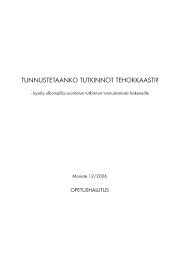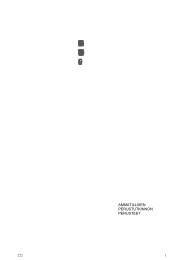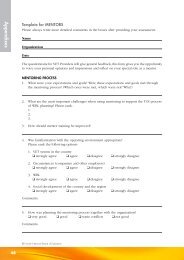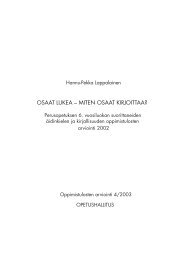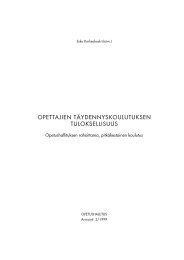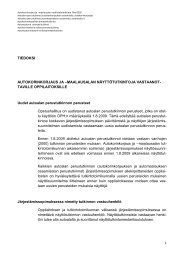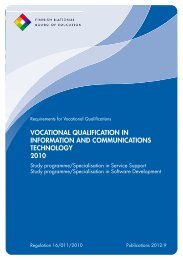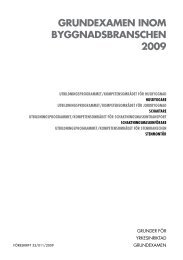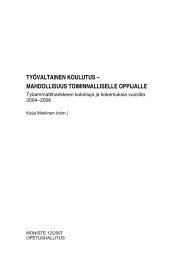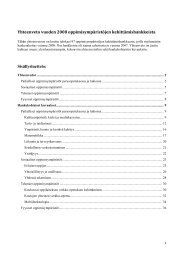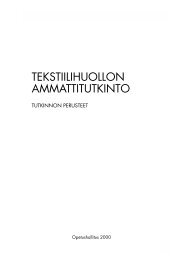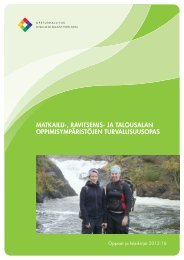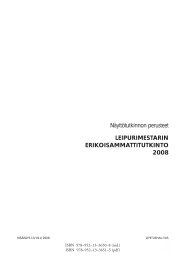School Library A Good
School Library A Good
School Library A Good
Create successful ePaper yourself
Turn your PDF publications into a flip-book with our unique Google optimized e-Paper software.
If the shelves are moveable and the electric solutions for<br />
the space are planned properly the tables can be easily put<br />
together in different ways and the school library will be able<br />
to accomodate the changing needs of teaching without major<br />
renovations over the years.<br />
Different learning strategies are taken into account in both<br />
the visual and the functional setting of the school library<br />
• Information is organised according to certain criteria to<br />
make locating it as easy as possible for the library user,<br />
e.g. PLC system i.e. the Finnish Public Libraries Classification<br />
System or UDC system i.e. the Universal Desimal<br />
Classification System.<br />
• The pupils are taught the classification system used in the<br />
school library as well as how to use it at school.<br />
• Classification done in conjunction with the compilation of<br />
the material catalogue may be different from the location<br />
marking (signum) i.e. the books may be placed in the<br />
shelves according to different crtiteria than what is used<br />
in the classification system, e.g. by themes (pedagogic<br />
starting point).<br />
• The planning of acoustics, lighting and electricity, air<br />
conditioning and maintenance should be done properly.<br />
• Different age groups taken into consideration when planning<br />
for furniture and classification system (the height of the<br />
shelves, chairs and tables, ergonometry).<br />
• The areas emphasised by the school curriculum are taken<br />
into consideration.<br />
• The school policy is reflected in the school library.<br />
• Presentation of the material is tempting and clear (short<br />
rows of shelves are easier to perceive than long rows, space<br />
and light around the shelves)<br />
An example from a model school library in Espoo<br />
• In primary education school libraries the nonfiction books are<br />
classified and placed on the shelves according to the PLC, but<br />
on the side of the shelf there is the name of the class, which is<br />
replaced by concepts that children understand. The number<br />
classification is not necessarily even on show but there may be<br />
a colour code on the back of the book.<br />
• In primary education prose is classified thematically on the<br />
shelves with stickers on the back of the book, e.g. fantasy (a<br />
dragon), horror (a skull), love (a heart).<br />
• Secondary education school libraries follow the PLC system<br />
both on the shelves and in the catalogueing , the shelf<br />
classification on the edge of the shelf together with the PLC<br />
term.<br />
The three functional areas of<br />
the school library<br />
1. Managing the collection<br />
• school librarian’s desk, cupboard, storeroom depository,<br />
reception of books<br />
• library programme: catalogueing, borrowing<br />
• working area, where one can maintain and handle books<br />
(repairing, covering books with plastic, catalogueing)<br />
2. Information retrieval<br />
• reference resources (nonfiction books, magazines, cd-roms)<br />
• computers equipped with internet connection for<br />
information retrieval<br />
• access to e.g. material and article databases<br />
• tables for working<br />
• group work areas, where the group can work together and<br />
have discussions whilst working<br />
• a quiet area for doing homework, or for listening for tapes<br />
and compact discs with headphones<br />
3. Reading<br />
• new and interesting children’s, youth and adult literature<br />
for all kinds of readers placed according to the library<br />
classification system<br />
• areas where pupils of different age easily find reading to<br />
suit their purposes:<br />
• pre-primary and primary education area has low shelves<br />
and the books clearly on show, e.g. the cover facing the<br />
viewer<br />
• in the area aimed at the older readers the classification of<br />
books by themes, thematic shelves, e.g. fantasy, love and<br />
friendship, adventure, nature, comic books, etc.<br />
• magazine rack where magazines targeted at different age<br />
groups (children, youth, adults) can be found (nature,<br />
animals, games, computers, youth, science, art, motors<br />
and engines, sports, music, cinema, culture, etc.) and at<br />
least one newspaper.<br />
• comfortable seats for sitting, browsing and reading in<br />
comfort and with enjoyment<br />
• a place for having story time sessions, book reviews to<br />
promote reading for pleasure, and telling stories<br />
• in upper secondary schools also a newspaper room with<br />
tables for reading together<br />
A <strong>Good</strong> <strong>School</strong> <strong>Library</strong>



